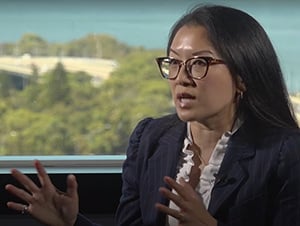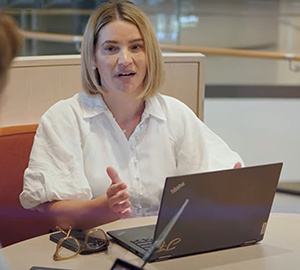
September 12, 2024
‘Vital to promote diversity and attract the next generation of inspirational leaders’
A former mining opponent, a brilliant materials engineer and a respected leader in the male-dominated offshore drilling space are among the winners of Australia’s 2024 Women in Resources National Awards announced in the nation’s capital this week.
Queensland University of Technology PhD student and BHP portfolio lead Ashara Moore followed up her Exceptional Young Woman in Queensland Resources award earlier this year by taking out the national award.
Group manager of materials and innovation at Western Australia-based Callidus Process Solutions, Dr Evelyn Ng, took out the Maptek Woman in Resources Technological Innovation award.
Dr Evelyn Ng

Head of energy group Woodside Energy’s global wells and seismic arm, Josie Fourie, received the Dyno Nobel Exceptional Woman in Australian Resources award. The winner of the 2024 WA Outstanding Woman in Resources award is a chemical engineer who has spent 25 years in the upstream energy sector, becoming the most senior woman in offshore drilling in Australia.
Josie Fourie

Moore, Ng and Fourie were among 29 women and four organisations nominated for six awards at the 11th annual Women in Resources National Awards in Canberra, hosted by the Minerals Council of Australia in partnership with the New South Wales Minerals Council, the Queensland Resources Council, the Chamber of Minerals and Energy WA, the Tasmanian Minerals, Manufacturing and Energy Council and the South Australian Chamber of Mines and Energy.
The awards are supported by Women in Mining Network state branches.
Queensland-based Kanae Dyas, workplace support manager at Anglo American, took out the Rio Tinto Inclusion and Diversity Champion in Australian Resources Award.
Nadine Hill, an openpit supervisor at Evolution Mining’s Cowal gold operation in NSW, won The Bloomfield Group Outstanding Tradeswoman/Operator/Technician Award.
Major mining services group Thiess headed four groups who were vying for the Mitsubishi Corporation Development Diversity Programs and Performance Award with its Mt Arthur South Indigenous/Inclusive Trainee Employment nomination.
WA Chamber of Minerals and Energy CEO Rebecca Tomkinson said Fourie and Ng were shining examples of the growing pool of talented women breaking new ground in the resources industry.
“Women comprise a growing proportion of the sector’s work force and they’re not just making up the numbers. In so many instances they are highly respected leaders driving innovation in their fields,” Tomkinson said.
“The industry has a long-standing focus on improving diversity. The benefits of that approach are on full display through the field of hugely impressive finalists selected for the 2024 awards.
“While much work has already been done, boosting female participation – from mine sites and laboratories through to the boardroom – remains a priority for the sector.
“Highlighting the achievements of exceptional women like Josie Fourie and Dr Evelyn Ng is a vital part of continuing to promote diversity and attracting the next generation of inspirational leaders.”
Ng, who started her career with First Quantum Minerals at Africa’s largest copper mine in Zambia, has worked on five continents and in her current role at Perth-based Callidus is said to be the only materials engineer among more than two dozen mechanical engineers in a company with over 300 employees.
Ng leads forensic investigations of plant and machine failures, developing quality assurance specifications, as well as overseeing the group’s R&D and intellectual property.
Two recent Callidus patents – one for a bi-metallic coating system and another involving titanium-nitride surface hardening – are seen to have potential to be game-changers in the mining industry.
Ashara Moore, who wants to change tailings management in mining, admitted in an interview after she won a 2023 Women in Industry Award in Queensland she had gone into a work experience interview with Rio Tinto “morally opposed” to the industry.
She said after early exposure to the industry and then starting her career she came to see it “was trying to do and be better [and] it was a sector that I thought I could make a positive difference within”.
Through her QUT PhD study Moore wants to develop a new carbon reduction technology (CRT) that can help mines cut emissions and positively impact future management of tailings.
“I am pro finding solutions to ensuring that our sector can peacefully co-exist with our environment,” Moore has said.
“Tailings management … is the avenue in which I wish to play my part.
“My PhD study is just one very small, very niche segue toward achieving that goal.
“By targeting mining waste, one of the most substantial potential environmental impactors within industry, and hopefully finding more sustainable and responsible ways of managing this waste, I hope to contribute to the ESG agenda gaining momentum in the sector.
“I am hoping to achieve a new normal about the way we think about tailings waste.”
Last August she presented her preliminary findings to the World Chemistry Conference in the Hague, Netherlands.
IMARC applauds winners of this year’s 2024 Women in Resources National Awards.
So far, more than 130 confirmed speakers at this year’s International Mining and Resources Conference in Sydney are women, ranging in roles from the C-suite through to undergraduate students. IMARC's Balance for Better commitment also includes the working partnerships with industry groups IWIMRA, WISER, WIMnet NSW, WIMARA, to name a few.
IMARC chief operating officer Anita Richards says the large contingent of female speakers reflects the event’s “unwavering commitment to balance for better, an initiative dedicated to promoting equality, diversity, and inclusion throughout the mining sector”.
The Conversation (0)
Latest News
Latest Press Releases
Related News
TOP STOCKS
American Battery4.030.24
Aion Therapeutic0.10-0.01
Cybin Corp2.140.00